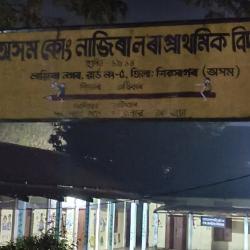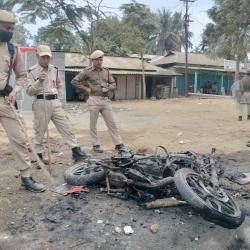Greater resources and stronger political commitment critical in tackling Malaria: WHO
Malaria, a disease without borders, is preventable and treatable however it needs a bolder commitment from donors and member states if it is to be brought under control.
Malaria remains a major health problem in the South-East Asia region with 83% of its population at risks. There are an estimated 20 million cases and 100,000 deaths each year from malaria in the region.
"Today we have powerful new tools and effective models of control, which is critical in our approach in tackling this disease. But financial resources need to be mobilised and political commitment to addressing this disease needs to be solidified. A lackadaisical attitude to this health issue will not lessen the current disease burden," said Dr Samlee Plianbangchang, WHO Regional Director for South East Asia marking the first World Malaria Day.
Populations particularly susceptible to malaria include those who live in urban slums, the poor, ethnic groups, mobile populations, young adults and border communities. In South-East Asia, where some of the most devastating resurgences of malaria have occurred, the disease continues to pose a serious threat to public health. Much of the malaria in this Region is transmitted by forest-dwelling vectors, making vector control extremely difficult and also leaving large infected populations beyond the reach of basic health infrastructure.
Malaria is endemic in all the countries in the South-East Asia Region except the Maldives, and the situation is becoming increasingly difficult to control. This region also harbours two main malaria parasites, the deadly Plasmodium falciparum and Plasmodium vivax, which is notorious for causing relapsing episodes. In addition to damage to health and well being, malaria adversely affects economic development particularly the livelihood of the poor. "A community with malaria is an impoverished community," stressed Dr Plianbangchang.
Parasite strains resistant to chloroquine, (cheapest and most common anti-malaria drug), have spread throughout this region. Multidrug-resistant strains are present in several countries and the resistance level is growing, posing a threat to all means of effective case management. Intensified efforts by Member countries, international agencies, partners and donor agencies are urgently required.
Other Contents by Author
The smoke-free policies in India were enforced since 2 October 2008 and different states are at varying levels of its implementation, yet the tobacco cessation services are still limited to very few clinics in India.A lead article published in The Economist (7-13 March 2009) says: "tobacco is more addictive than virtually all of them [narcotic drugs]."With tobacco being highly addictive, it is clear that for a successful implementation of the smoke-free policies, the scaling up of high-quality and reliable tobacco cessation services can no longer be ignored."Large areas in central and north-east India have more than 65 per cent tobacco use" said Dr Pratima Murthy, who is the...
On 23 January 2009, the Group of Ministers (GoM) in India will again meet to assuage concerns of tobacco lobby on pictorial warnings, health activists apprehend.This group of ministers (GoM) consists of: Pranab Mukherjee (External Affairs Minister), Kamal Nath (Commerce and Industry Minister), Priyaranjan Dasmunsi (former Information and Broadcasting Minister), S Jaipal Reddy (Urban Development Minister), Dr Anbumani Ramadoss (Health and family welfare Minister), and Oscar Fernandes (labour and employment Minister for state). The pictorial warnings on tobacco products are proven to reduce tobacco consumption. Particularly in countries like India, where literacy rates are alarmingly low, it...
To confront the present war posturing between India and Pakistan, the citizens of both countries are launching a joint signature petition campaign on 9 January 2009, to voice their mandate against terrorism, war posturing and to promote mutual cooperation and peace. This signature petition campaign shall conclude on 8 February 2009, after which these signatures shall be handed over to the heads of both the nations along with other prominent stakeholders. Citizens of both nations can also sign online here or by going to the following URL: http://www.PetitionOnline.com/ indopak/petition.html The petition states that the citizens of Pakistan and India demand that: The Government of Pakistan...
The first patient was successfully treated by the state-of-the-art technology in radiotherapy – linear accelerator, which began functioning last week at RR Cancer Institute and Research Centre, Sri Ram Murti Smarak Institute of Medical Sciences (SRMSIMS), Bareilly in India.A linear accelerator (LINAC) is the device most commonly used for external beam radiation treatments for patients with cancer. The linear accelerator can also be used in stereotactic radiosurgery similar to that achieved using the gamma knife on targets within the brain. The linear accelerator can also be used to treat areas outside of the brain. It delivers a uniform dose of high-energy x-ray to the region of the...
India is reeking under increasing communal polarisation and urgent steps to check it are warranted. Between 24 August and 2 October 2008, more than 300 villages in 14 districts of Orissa state were affected by communal violence. 4,300 houses were burnt and 57 people were killed. 2 women were gang-raped. 149 churches and 13 educational institutions were attacked. In Kartnataka state, 19 churches in 4 districts were attacked and 20 women sustained serious injuries. In other states of India, like in Kerala 3 churches were attacked, in Madhya Pradesh 4 churches were attacked, and one church was attacked in Delhi and Tamil Nadu each. In the state of Uttarakhand, 2 people were killed. In all the...
India has boldly enforced the smoke-free policies banning smoking in public places and private areas with public access from 2 October 2008 – the birth anniversary of the father of nation Mahatma Gandhi.The government of India and countless people who have been advocating the enforcement of public health policies need due credit. It was certainly not so easy, more so because of the financially robust, strategically shrewd tobacco industry that has mastered the art of circumventing public interest policies and promoting a product (tobacco) that kills even when used as intended by the manufacturer.The tobacco industry, and other corporations or associations like ITC ltd, Indian Hotel...
The 3rd edition of the "Global Tobacco Treaty Action Guide 2008: Protecting Against Tobacco Industry Interference" was released earlier this week in many countries including India, during International Week of Resistance (IWR) to tobacco transnationals (22-28 September 2008). The Global Tobacco Treaty Action Guide 2008 is produced by Corporate Accountability International [which is in official relations with the World Health Organization (WHO)], along with the Network for Accountability of Tobacco Transnationals (NATT).The need for IWR was never so acute – when on one hand government of India is resolved to enforce the nation-wide ban on smoking from 2 October 2008, the...
It is a pity that India's robust smoke-free policies have been challenged by those with vested interests neglecting the immense and undisputed proven public health benefits of implementing such policies for people at-large. India is to ban smoking in public places nation-wide from October 2. However the ITC Limited and the Indian Hotel Association are among those who have challenged these public health policies in the court of law. The hearing by the honourable court is due."Secondhand smoke, also know as environmental tobacco smoke (ETS), is a mixture of the smoke given off by the burning end of a cigarette, pipe or cigar and the smoke exhaled from the lungs of smokers. It is...
There is a growing consensus to raise awareness about diabetes in the 50 days leading up to World Diabetes Day on 14 November 2008. The International Diabetes Federation announced that the theme for this year's campaign is "Diabetes in Children and Adolescents."Diabetes is one of the most common chronic diseases to affect children. It can strike children of any age, even toddlers and babies. Every day more than 200 children are diagnosed with type 1 diabetes, requiring them to take multiple daily insulin shots and monitor the glucose levels in their blood. It is increasing at a rate of 3% each year among children and rising even faster in pre-school children at a rate of 5% per year...
All tobacco products will display approved pictorial warnings and nicotine-tar levels from 30 November 2008, as per a notification issued by the Indian Ministry of Health and Family Welfare (dated 27 August 2008), in accordance with the Cigarettes and Other Tobacco Products (Prohibition of advertisement and Regulation of Trade and Commerce, Production, Supply and Distribution) Act, 2003. The implementation of pictorial warnings on tobacco products in India was initially planned for February 2007, but got deferred four times thereon.Grim images of diseased lungs will appear on cigarette, bidi and gutkha packets, as per the notification, covering 40 per cent of the surface area of the tobacco...










Add new comment